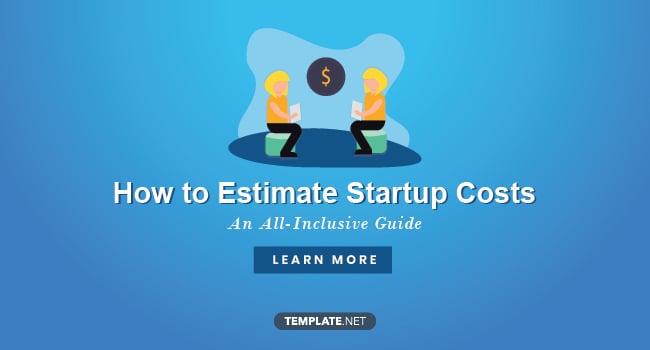How to Estimate Startup Costs
The majority of us have childhood dreams—some simple and others extraordinary. While others envision themselves journeying through outer space or climbing the highest mountains on Earth, some see themselves as renowned entrepreneurs in their desired industry. When that dream is close enough, the next step is to gather the right resources to get started. In establishing a business, different sets of requirements hound the business owner. From business finance to hiring people, there are lots of things to do. More importantly, you—as the entrepreneur—have to gather sufficient capital for the startup costs. Instead of worrying about where to collect information on possible expenses, read on as this article serves to guide you through the costs that come with opening a business.

How to Estimate Startup Costs
Expenses for Conducting Researches
Let’s say that for the longest time, you’ve wanted to open a sushi bar. First you select the contents of the menu and the interior design of the place. Afterwards, you do a cost analysis to help create a budget before opening your bar to the public. What could go wrong, you ask? In this scenario, let’s say that you discover that few people in the neighborhood are actually fond of Japanese cuisine. Failing to catch on, your bar goes out of business. From there, you deduce that investigating your market is essential for future endeavors. CB Insights reiterates this point through a study they conducted in 2019. Without any prior knowledge of the industry, your location, and your audience, any company you establish is more likely to fail. Therefore, allocating funds for research is crucial for any newly-formed enterprise.
The Types of Costs to Remember

Being new in the industry brings different challenges, mostly on the side of preparing plans and executing those marketing strategies. Besides that, you also have to be aware of the various costs of running a business. Here are the types of expenses you will meet in the process.
One-time Expenses
These one-time expenses are pieces of machinery and equipment that you purchase before the beginning of business operations. In addition, company licenses, permits, and legal fees fall under this section. If the company needs computer technology for some procedures, it’s also a one-time expense. Therefore, anything that you purchase outside the usual activities of the business becomes a one-time cost.
Ongoing Expenses
Unlike one-time expenses, the list of ongoing costs is a continuous cycle for your business. The company has to put out money for paying rent, providing benefits and payroll for employees, budget for marketing and advertising materials, and the maintenance of the machines conducting operations for the enterprise. If the payment for one of these things gets delayed, it will also disrupt the workflow of your company.
Essential Expenses
Similar to and sometimes part of your ongoing expenses, essential expenses are crucial components that help in the processes of the business. It has two branches: fixed and variable expenses. With that said, you have to understand the difference between these categories. The former remains constant despite the changes in the market, while the latter is dependent on the fluctuations in business activity. Labor costs, wages of employees, leases, business insurance, and utilities are examples of fixed expenses. On the other hand, operational fees, commission, taxes, shipping, and research budget are variable expenses. When you know these things, calculating the financial and business plan becomes easier.
Optional Expenses
Often called discretionary expenses, this form of cost is not necessary for the business. That means you can exclude these things from your cost estimation. For instance, getting promotions for your products and services through social media is an excellent move for companies, but it’s not a need—there are other ways to advertise goods. Spending for company outings and trips is not necessary for the business, but it can boost employee retention. With that, you have to make sure you discern essential and optional expenses from each other.
Identify Your Milestones
Before starting the company, you first have to identify the milestones that your business needs to meet. These achievements would be the basis for how well the company is doing. An example would be product launching and its assessment reports. This kind of activity requires specific strategic approaches and budget planning, which needs funds. For business owners like yourself, setting the plans in worksheets will help make accounting and premises cost more accurate. Set up goals, create outlines, and then execute them.
Generate a List of Expenses
When finished with that part, you can proceed to list down the expenses of your business. Since you have no previous data from reports, invoices, and trackers, the option is to look at information from other sources. By learning how other businesses, similar to your own, calculate their expenses—both daily, monthly, and yearly—you can produce a rough draft of the money you’ll need to have for the company. The list of expenses can cover the allocated funds for surveys, interviews, and researches for business plans and marketing proposals. You have the last say on what things to include in the list.
Discuss the Projected Cash Flow
It’s not only about expenses and allocation of resources. You also have to include the projected cash flow of your business. Through the profit and loss estimation and cash flow statements, you can determine the stability of the enterprise. Although the company has not begun operations, having a rough calculation of the returns will help boost the morale of the people running the business. Create an evaluation and revise some areas in the business structure that appear faulty. At best, the materials and the budget should be ready before the business operations and hiring starts.
Implementing Methods of Increasing Finances
Right now, you may have sufficient funds for startup costs. But with markets changing rapidly because of the economic friction between different nations, being prepared is always the best option for you. In case of emergencies, you can implement various methods to raise money for your business. Bank loans and business partnerships are useful ways of getting enough funding for the company. You can also schedule training and development seminars for employees to improve their interpersonal skills—thus, effectively communicating with clients and raising customer retention.
Dreams do come true. If we look at people enjoying the fruits of their labor, we can say that determination, coupled with hard work and the right tools, can help make these aspirations a reality. To start and grow your business means to look at new things and to try applying them to the company. From location selection, being the planner for business projects, and setting SMART goals, these decisions depend on you. With that, you have to consider the things that play an important role in the development of the business. Choose the right plans, learn how to do cost estimation, know how to balance the different aspects of the company, and keep being updated with the changes in the market.






